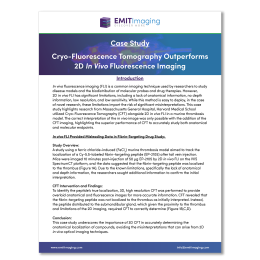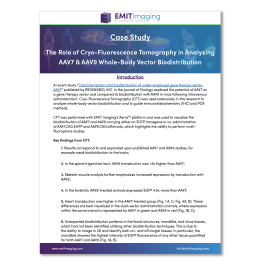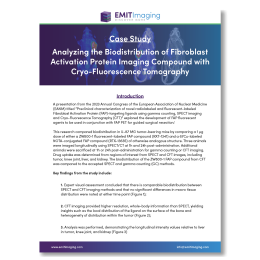Cryo-Fluorescence Tomography Outperforms 2D In Vivo Fluorescence Imaging
Data used with permission from Junfeng Wang, PHD | Massachusetts General Hospital, Harvard Medical School
Summary
In this case study, researchers from Massachusetts General Hospital, Harvard Medical School showed how 2D in vivo fluorescence imaging (FLI) failed to accurately localize compounds in complex biological models, leading to misinterpretations. By integrating high resolution, 3D imaging through CFT, the study revealed critical anatomical and molecular insights that were missed using traditional optical imaging methods.
This case study highlights CFT’s superiority in sensitivity, resolution, and anatomical context compared to in vivo FLI. Learn how CFT corrected initial misinterpretations and provided reliable data in a fibrin-targeting drug study, empowering researchers to make better-informed decisions.
The Role of Cryo-Fluorescence Tomography in Analyzing AAV7 & AAV9 Whole-Body Vector Biodistribution
Data used with permission from REGENXBIO, INC
Summary
This case study highlights the role of EMIT Imaging and Cryo-Fluorescence Tomography (CFT) in analyzing AAV7 and AAV9 whole animal drug biodistribution. The data was recently published by REGENXBIO, INC. in the Journal of Virology and explored the potential of AAV7 as a gene therapy vector and compared its biodistribution with AAV9 in mice following intravenous administration. CFT was used extensively in this research to analyze the whole-body vector biodistribution and to guide IHC and PCR methods. Download the case study below to learn how EMIT Imaging and CFT can help you discover more from your gene therapy research.
Analyzing the Biodistribution of Fibroblast Activation Protein Imaging Compound with Cryo-Fluorescence Tomography
Data used with permission from Ratio Therapeutics
Summary
This case study highlights the role of EMIT Imaging and Cryo-Fluorescence Tomography (CFT) in analyzing the biodistribution of a Fibroblast Activation Protein (FAP) imaging compound. This research compared biodistribution in U-87 MG tumor-bearing mice by comparing a ZW800-1 fluorescent-labeled FAP compound and a 67Cu-labeled NOTA-conjugated FAP compound of otherwise analogous structure. Animals were sacrificed at 1h or 24h post-administration for gamma counting or CFT imaging and drug uptake was determined from regions of interest from SPECT and CFT images, including tumor, knee joint, liver, and kidney. Also, the biodistribution of the ZW800-1 FAP compound from CFT was compared to the accepted SPECT and gamma counting (GC) methods.




